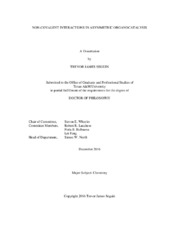| dc.description.abstract | The stereochemical outcomes of asymmetric organocatalytic reactions are the result of myriad competing forces in the stereocontrolling transition states (TSs). An often potent factor governing stereoselectivity are differential non-covalent interactions, which modern computational techniques make possible to examine in detail. Studies of the origins of stereoselectivity in asymmetric organocatalytic reactions not only uncover key information regarding the mode of asymmetric induction, such as the strength of various non-covalent interactions, but can also inform future rational catalyst design.
In the first part of this dissertation, an analysis of the stereoselectivity in the first example of a stereoselective, catalytic Fischer indole synthesis, utilizing chiral phosphoric acid catalysts, shows that selectivity results from competition between CH/π and π/π interactions in the lowest-lying transition states. In the second part, a general model is presented for the stereoselectivity of chiral phosphoric acid-catalyzed meso-epoxide ring-openings, in which the lowest-lying transition state structure contains a favorable electrostatic CH···O interaction due to the stereospecific restriction of substrate orientations. In the third part, it is shown that a complex, variable interplay of non-covalent interactions are responsible for the stereoselectivity in chiral phosphoric acid-catalyzed enantioselective oxetane desymmetrizations. Finally, it is shown in a recent example of ion-pairing organocatalysis of a Diels-Alder reaction, that both dispersion and electrostatic-based interactions control the selectivity, the former as a result of cyclopentadiene nestled in a cleft between the dienophile and aromatic backbone of the catalyst, and the latter as a result of stronger CH···O interactions between the cationic substrate and the anionic catalyst core in the favored transition state. | en |


